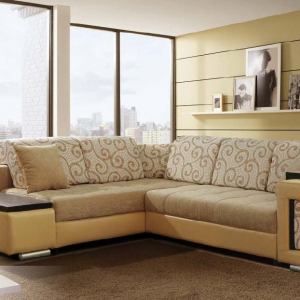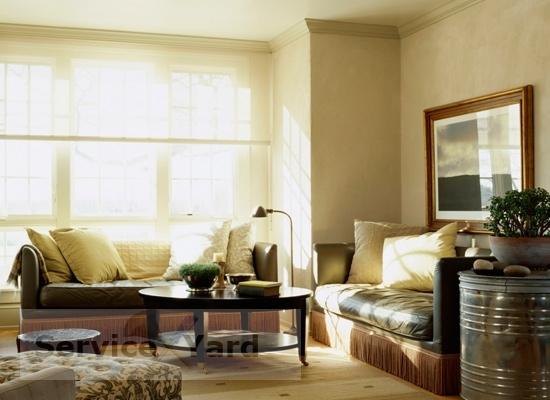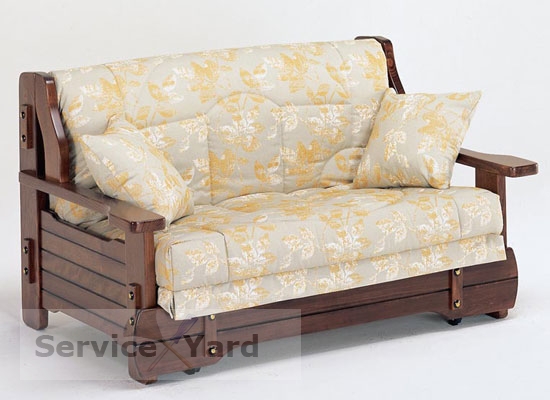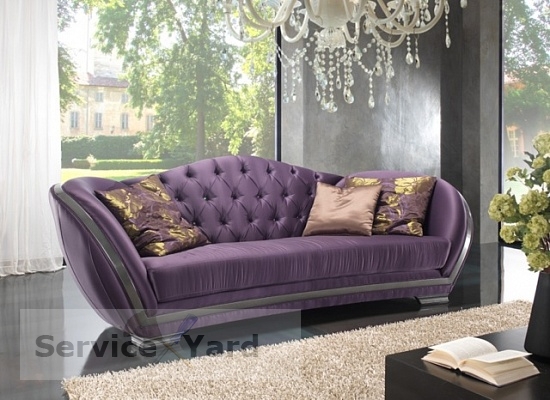DIY furniture

Many men have at least once in their life independently repaired upholstered furniture or made a constriction of a sofa, armchairs, but upholstered furniture with their own hands is always an exclusive thing and will always be a source of pride and success. Do not think that making furniture with your own hands is an overwhelming and difficult job. The presence of skills in carpentry will help to make a frame, which can then be sheathed or wrapped in soft upholstery. How exactly to do this, you will learn from this article.
to contents ↑Preparatory stage
Preparing to make upholstered furniture with your own hands is the most responsible process. The final result depends on how competently and thoughtfully you are to perform work at this stage - both in terms of strength and beauty of the headset, and in its durability and advisability for the interior and the size of a particular room.
Choosing the furniture you need
If you decide to make furniture yourself, then make an action plan. First decide what functionality your furniture should have. The choice of material, accessories and upholstery depends on this.
Drawings development
 If you have drawing skills, then draw a sketch and draw drawings of all the elements of the future product. If you do not have such skills, then find the sketches you are interested in on the Internet. It can be either finished projects or special programs for creating sketches and visualizing the result.
If you have drawing skills, then draw a sketch and draw drawings of all the elements of the future product. If you do not have such skills, then find the sketches you are interested in on the Internet. It can be either finished projects or special programs for creating sketches and visualizing the result.
What to give preference to and how exactly it will be more convenient for you to make furniture with your own hands at home, decide based on your own concepts of practicality and convenience. But be sure to note that the sizes and shapes of all elements must be calculated and drawn on paper at a reduced scale. A good drawing of the future element of furniture with all the necessary explanations is the key to successful assembly.
Important! Furniture design can be thought out independently, but it is better to study factory items in order to understand how certain parts are attached and what materials and accessories are needed for various furniture items.
The choice of materials for the manufacture of furniture
For work, materials of various types will be required:
- The main materials for the manufacture of furniture are fiberboard, particleboard, wooden blocks, flexible MDF sheets. 80% of upholstered furniture may consist of such a frame. Preparation of product elements is carried out using a carpentry machine, jigsaw.
- It is also necessary to choose a filler for the elements of the product. It can be polyurethane or foam rubber. The thickness of the material depends on how much of the furniture is upholstered. For seats, use the thickest filler, and for armrests on sofas and armchairs - the thinnest.
- Elements for which foam rubber is laid must be covered with a coarse cotton cloth.
- Depending on the elements of products, for assembly, you may need both ordinary screws and nails, and various metal elements: fasteners, corners. All necessary materials, fittings, fasteners and other supporting materials should be calculated and included in the purchase and acquisition plan.
to contents ↑Important! Of great importance in the process of how you will make upholstered furniture for your home with your own hands is the choice of fabric for covering. It should be a strong and high-quality fabric.Before starting to sheathe it with furniture, it is necessary to experiment and determine whether contaminants, damage are easily removed from the sheathing and whether arrows and holes from nails form on it. The upholstery fabric should be in harmony in color and texture with the textiles and curtains in the room. Upholstery can be attached to furniture elements with a stapler or carnations.
Production of upholstered furniture elements
The manufacturing process of upholstered furniture is divided into 2 stages:
- Create a wireframe. This process will not be difficult if you have the skills in carpentry.
- The connection of all structural elements with the laying of the filler and the installation of the covering of chairs and sofas.
The base can be rigid, flexible and flexible:
- Hard bases include frames and boxes with plugs made of plywood or solid wood fiber board.
- Flexible and elastic bases are a frame or box, on one side of which support structural elements are installed, which make it possible to bend.
Work with individual parts begins with their marking on the material. Everything must be carefully and thoroughly checked, and only after that start cutting the workpieces using an electric jigsaw or a carpentry machine.
to contents ↑Important! If all the details are made in accordance with the drawings, then the first fitting will show how clearly the elements fit together. If necessary, correct errors immediately, adjusting the elements to full compliance. In this case, do-it-yourself furniture at home will be made efficiently.
Determining the type of joining parts
The type of connection depends on the purpose and functionality of the product:
- If upholstered furniture is planned for continuous use in one condition, then the elements must be connected using nails, screws, screws or glue.
- If you plan to disassemble or lay out the furniture, then use the so-called foot-type fastening method.
At the same stage, process all the sharp corners of the elements so that they do not appear through the upholstery and do not cause discomfort in the future.
to contents ↑Important! When joining the parts, attract additional working hands, as this alone is problematic.
We create furniture upholstery:
- Fit the items to be upholstered with fabric until the entire structure is assembled.
- When patterning material, take into account all the twists on the furniture and, in addition, leave a couple of centimeters for allowances at the edges.
- According to the pre-made blanks, cut the material and fix it on the elements with the help of brackets.
- Make sure that accessories (fasteners) are not visible to others.
 The general recommendations listed above are applicable for the manufacture of certain types of upholstered furniture, in particular, poufs and sofas.
The general recommendations listed above are applicable for the manufacture of certain types of upholstered furniture, in particular, poufs and sofas.
Making pouf
This household item has multifunctionality. It is not only an element of decor, but can serve as a convenient place to store things and serve as a chair. There are many options for making ottoman. It can be frame and frameless, rectangular and round, sheathed fabric and knitted. We offer you the technology of how to make upholstered furniture with your own hands at home such as a rectangular frame pouf with a standard size of 400x400x500 mm.
Materials
To make it, you will need the following tools and materials:
- Wooden beam 150x40x40 mm.
- A piece of chipboard 1750-2400x16 mm.
- Hammer.
- Hacksaw with small teeth.
- Pencil and ruler.
- Screwdriver.
- Joiner's glue.
- Wood screws.
- Stapler for upholstery.
- Upholstery material (synthetic winterizer, batting, foam rubber) 50 mm thick.
- 2 piano loops.
- 4 clips.
- Thick fabric for upholstery.
- Sewing machine.
Installation instructions:
- Mark on the work surface:
- For the walls of the pouffe, cut 2 rectangular pieces measuring 370x400 mm.
- For the side parts, use a hacksaw to cut 2 segments of 370x400 mm, 1 segment of 400x400 mm.
- Saw the timber into 4 parts so that each of them has a length of 370 mm.
- Assemble the box from the cut out elements. The frame should have a height of 370mm.
- Use wood glue to glue the bars along the inner corners of the structure.
- Fix the corners of the frame with self-tapping screws.
Important! If desired, reinforce the structure with metal corners. This will give greater reliability to your home-made upholstered furniture.
- Place the top cover (400x400 mm) on the foam sheet and cut the desired piece of material. About three pieces are needed on the seat, because it should be soft. Cut 3 squares, glue them together.
- Glue the foam to the top cover.
- Cut 4 narrow strips of foam rubber, fill the gap between the lid and the large square of foam rubber with them.
- Make a sketch of cutting the upholstery of the top cover, measuring the finished ottoman pasted with foam. Do not forget to add 1 cm to all seams. Similarly, do all the calculations for the sides of the ottoman. Leave 6 cm of material on the lower and upper bends.
- Transfer the sketch to the fabric, carefully cut the workpieces.
- Start sewing, stitching decorative seams first.
- Put the finished neat cover on the ottoman so that the corners coincide.
- Having slightly cut the corners, make a bend, and then nail the material with a stapler to the box. Nail the lower part of the fabric as well.
- Perform the same manipulations with the top cover, fixing the material on it.
- Pull the fabric, make a small room and beat the brackets to the chipboard.
- Make a neat tongue from the fabric, beat it to the top cover so that the ottoman can easily open.
- Attach the mechanism by which the cover will open with self-tapping screws.
- Attach 4 casters to the bottom.
The ottoman is ready! You can use it for its intended purpose.
to contents ↑Stage-by-stage creation of a sofa
 Making upholstered furniture with your own hands at home is a rather complicated and time-consuming process, especially creating a sofa. Therefore, before starting work, think carefully about every detail of the structure. Pre-design each element on paper. The more detailed the sketch, the easier it will be to make a sofa.
Making upholstered furniture with your own hands at home is a rather complicated and time-consuming process, especially creating a sofa. Therefore, before starting work, think carefully about every detail of the structure. Pre-design each element on paper. The more detailed the sketch, the easier it will be to make a sofa.
Important! Basically, the sofa has a length of 1.9 m, the height of the back is 0.75-0.85 m.
Device and accessories
The main elements of the sofa include:
- Wireframe.
- Seat.
- Back.
- Legs.
- Armrests.
- Accessories - you can sew decorative pillows.
Important! The frame is the main component, and the operational characteristics of the sofa depend on how well it is executed.
Materials and Tools
To make a sofa, you will need the following tools and materials:
- Wooden beam.
- Particleboard, fiberboard.
- Tarpaulin plywood.
- Upholstery material (synthetic winterizer, foam rubber, batting).
- Decorative furniture fabric.
- Ruler, pencil.
- Furniture glue.
- Electric drill.
- Electric jigsaw.
- Nails, screws.
- Screwdriver.
- Hammer.
- Knife, scissors.
- Furniture stapler.
- Sewing machine.
Assembly technology:
- According to the drawn up drawings, cut out the base for the future product. Cut the plywood mold using an electric jigsaw. If the product will have a complex shape, then make the base of several parts that are joined together.
Important! It is easiest to cut the base from shields or plywood sheets left over from old furniture.
- Attach the uprights to the base, then the horizontal partitions.
Important! Decide on the height of the sofa in advance. A sofa can be made lower and a kitchen sofa taller.
- Place plywood on the frame of the product.
- Fix the plywood to the frame with furniture glue, screws.
- After assembling the frame, begin mounting the backrest. It should be proportionate to the base of the sofa. Assemble the backrest in the same way as assembling the frame.
Important! The upper and lower backrest beam should have a width of 8-9 cm.
- Attach the backrest to the base with metal angles.
- Treat the frame with sandpaper, plus, if necessary - paint or varnish.
- Start making soft blanks: from furniture fabric and foam rubber, make 2 bases 20-30 cm thick.
- Connect the basics with a furniture stapler or detachable zipper.
Important! To prevent the foam from wearing out quickly, wrap it in a synthetic winterizer.
- Made soft pillows, attach to the base of the sofa with Velcro tapes.
Stock footage
We described the manufacturing technology of the simplest design of the sofa. Such furniture can be used in the country or balcony. If you learn how to make simple models, it will not be difficult for you to create more complex designs, and upholstered furniture made by yourself will be the pride and joy of all households.
- How to choose a vacuum cleaner taking into account the characteristics of the house and coatings?
- What to look for when choosing a water delivery
- How to quickly create comfort at home - tips for housewives
- How to choose the perfect TV - useful tips
- What to look for when choosing blinds
- What should be running shoes?
- What useful things can you buy in a hardware store
- Iphone 11 pro max review
- Than iPhone is better than Android smartphones



